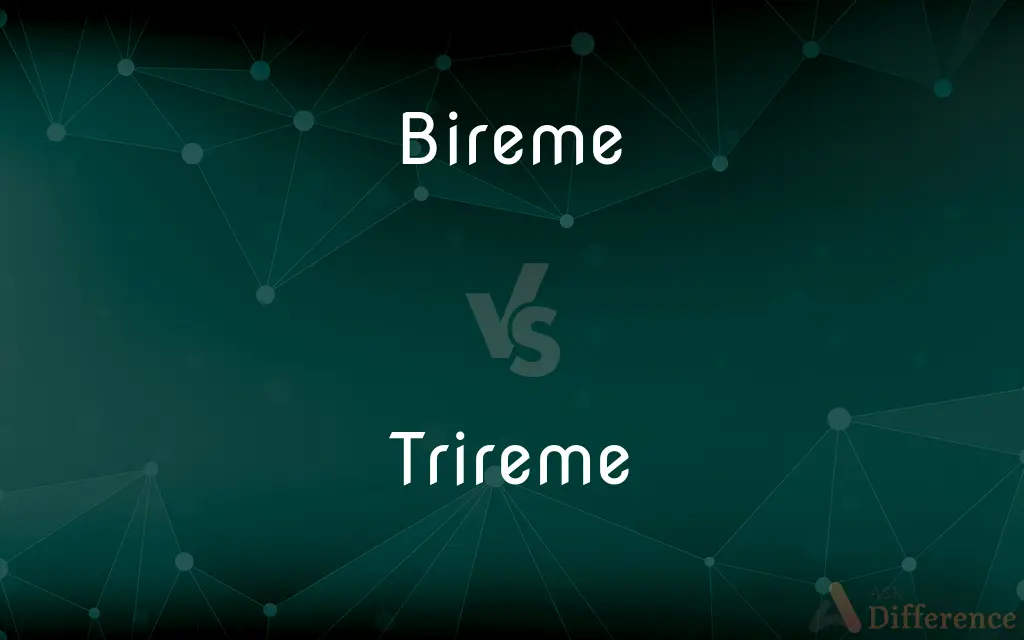Bireme vs. Trireme — What's the Difference?
Edited by Tayyaba Rehman — By Fiza Rafique — Updated on April 19, 2024
A bireme is an ancient rowed vessel with two tiers of oars, while a trireme has three tiers, allowing for greater speed and power in naval battles.

Difference Between Bireme and Trireme
Table of Contents
ADVERTISEMENT
Key Differences
The bireme, used in ancient naval warfare, featured two levels of oars on each side of the ship, making it more maneuverable than single-tiered vessels. On the other hand, the trireme, a development on the bireme, added an additional tier of oars, which significantly increased its speed and combat effectiveness.
Biremes were an evolution from the earlier monoreme, providing improved stability and speed due to their dual oar arrangement. Whereas triremes, evolving from biremes, capitalized on the advantages of having even more oarsmen, further enhancing propulsion and maneuverability.
In terms of size, biremes were typically smaller than triremes. This made biremes lighter and potentially faster in certain conditions, but they lacked the overall power and crew capacity of triremes. Conversely, the trireme's larger size and additional rowers made it a dominant force in naval battles, particularly famous in Classical Greek naval warfare.
The tactical use of biremes often involved rapid maneuvers and engagements in smaller naval skirmishes. On the other hand, triremes were the backbone of larger naval fleets, designed for head-on collisions and ramming enemy ships with their reinforced prows.
Although both ships were primarily driven by oars, the trireme's additional tier allowed for a denser configuration of oarsmen, translating into more power per stroke. This made triremes not just faster but also more robust in ramming tactics compared to biremes.
ADVERTISEMENT
Comparison Chart
Tiers of Oars
Two tiers of oars on each side.
Three tiers of oars on each side.
Size
Smaller and lighter, accommodating fewer rowers.
Larger, accommodating more rowers, hence heavier.
Speed and Power
Fast and maneuverable, suitable for quick strikes and retreats.
Faster and more powerful, designed for direct combat.
Tactical Use
Used in smaller skirmishes and for rapid maneuvers.
Used in major battles, capable of sustained combat and ramming.
Crew Capacity
Generally carried fewer sailors and soldiers.
Larger crew capacity, including more rowers and soldiers.
Compare with Definitions
Bireme
Often featured in historical naval warfare stories.
Biremes were prominent in the narratives of ancient sea battles.
Trireme
An ancient ship with three tiers of oars, designed for warfare.
Triremes were central to Athens’ dominance at sea during the Peloponnesian War.
Bireme
Known for its speed and agility in water.
The bireme’s design was crucial for quick coastal patrols.
Trireme
Required a large crew to operate efficiently.
Each trireme in the Athenian fleet was manned by over 170 rowers.
Bireme
A type of ancient ship with two tiers of oars on each side.
The bireme allowed for effective naval maneuvers in the confined waters of the Mediterranean.
Trireme
Used extensively in Greek naval strategy.
Greek commanders relied on triremes for both defensive and offensive maritime operations.
Bireme
Historically used by ancient maritime civilizations.
Ancient Carthaginians utilized biremes in their naval encounters.
Trireme
Known for its formidable speed and ramming power.
The trireme's design focused on maximizing impact during naval ramming.
Bireme
Smaller and less crew-intensive than triremes.
Biremes required fewer rowers, making them less costly to maintain.
Trireme
Featured prominently in classical literature and historical accounts.
Triremes are often mentioned in the works of Herodotus and Thucydides.
Bireme
A bireme (, BY-reem) is an ancient oared warship (galley) with two superimposed rows of oars on each side. Biremes were long vessels built for military purposes and could achieve relatively high speed.
Trireme
A trireme (, TRY-reem; derived from Latin: trirēmis "with three banks of oars"; Ancient Greek: τριήρης triērēs, literally "three-rower") was an ancient vessel and a type of galley that was used by the ancient maritime civilizations of the Mediterranean, especially the Phoenicians, ancient Greeks and Romans.The trireme derives its name from its three rows of oars, manned with one man per oar. The early trireme was a development of the penteconter, an ancient warship with a single row of 25 oars on each side (i.e., a single-banked boat), and of the bireme (Ancient Greek: διήρης, diērēs), a warship with two banks of oars, of Phoenician origin.
Bireme
An ancient galley equipped with two tiers of oars on each side.
Trireme
An ancient Greek or Roman galley or warship, having three tiers of oars on each side.
Bireme
(history) an ancient galley having two banks of oars, one above the other.
Trireme
A galley with three banks of oars, one above the other, used mainly as a warship.
Bireme
An ancient galley or vessel with two banks or tiers of oars.
Trireme
An ancient galley or vessel with tree banks, or tiers, of oars.
Trireme
Ancient Greek or Roman galley or warship having three tiers of oars on each side
Common Curiosities
Could a bireme compete effectively against a trireme in battle?
A bireme could maneuver quickly but was generally less effective in direct combat against a trireme due to its lesser power and crew size.
What kind of battles were biremes best suited for?
Biremes were best suited for smaller skirmishes and rapid maneuvers rather than large-scale naval battles.
Did triremes use sails as well as oars?
Yes, triremes were equipped with sails for travel under favorable wind conditions but relied primarily on oars for maneuvering and combat.
What was the primary advantage of a trireme over a bireme?
The primary advantage of a trireme over a bireme was its greater speed and power, derived from an additional tier of oars.
What are some examples of civilizations that used biremes?
Civilizations such as the Phoenicians and Carthaginians used biremes extensively in their naval operations.
How were these ships constructed in ancient times?
These ships were constructed using wood from specific trees like fir and cedar, assembled using advanced techniques that varied from one civilization to another.
Why did ancient civilizations develop triremes from biremes?
Ancient civilizations developed triremes from biremes to gain a tactical advantage in naval warfare, emphasizing speed, power, and ramming capabilities.
What happened to biremes and triremes in later historical periods?
Biremes and triremes gradually became obsolete as naval technologies evolved, particularly with the introduction of larger and more heavily armed ships.
How did the construction of a trireme differ from that of a bireme?
The construction of a trireme involved adding a third tier of oars, which required a sturdier hull and more complex design than a bireme.
How did the crew sizes of biremes and triremes compare?
Triremes had significantly larger crews than biremes, often with more than double the rowers to maximize their combat capabilities.
Are there any surviving examples of biremes or triremes today?
No original biremes or triremes survive today, though there are several modern reconstructions based on historical descriptions and archaeological evidence.
How did the design of these ships influence modern naval architecture?
The design principles of maximizing speed and maneuverability continue to influence modern naval architecture, although materials and technologies have dramatically changed.
What role did these ships play in the economies of ancient states?
These ships played crucial roles in protecting trade routes and asserting naval dominance, which were key to the economic prosperity of ancient maritime powers.
What is the historical significance of naval battles involving these ships?
Naval battles involving these ships often determined the outcomes of wars and the fate of empires, making them significant in world history.
How do historians and archaeologists study these ancient ships today?
Historians and archaeologists study these ships through literary sources, iconography, and shipwrecks, using modern technology like underwater archaeology to gather insights.
Share Your Discovery

Previous Comparison
Hitler vs. Mussolini
Next Comparison
Budesonide vs. AlbuterolAuthor Spotlight
Written by
Fiza RafiqueFiza Rafique is a skilled content writer at AskDifference.com, where she meticulously refines and enhances written pieces. Drawing from her vast editorial expertise, Fiza ensures clarity, accuracy, and precision in every article. Passionate about language, she continually seeks to elevate the quality of content for readers worldwide.
Edited by
Tayyaba RehmanTayyaba Rehman is a distinguished writer, currently serving as a primary contributor to askdifference.com. As a researcher in semantics and etymology, Tayyaba's passion for the complexity of languages and their distinctions has found a perfect home on the platform. Tayyaba delves into the intricacies of language, distinguishing between commonly confused words and phrases, thereby providing clarity for readers worldwide.













































